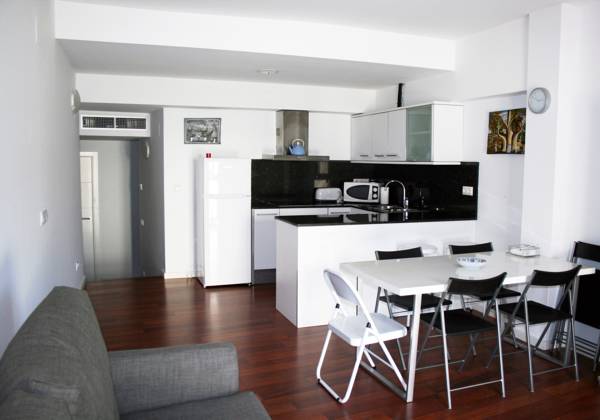
Girorooms Catedral , 2 rooms
From: To: Availability
Located 300 metres from Arab Bath Girona and a 5-minute walk from Girona Cathedral, Girorooms Catedral offers a spacious apartment with a balcony with city views.
The apartment comes with a living room with a sofa and a flat-screen TV; and a modern kitchen with oven, and bed linen and towels are provided. You can enjoy city view and river view from the room.
Several bars, restaurants as well as supermarkets acan be found within 3 minutes’ walk.
If you feel like visiting the surroundings, check out Girona Art Museum 400 metres away. Girona-Costa Brava Airport is located 11 km from the property.
Girorooms Catedral is in Girona
Capital of the Costa Brava region and one of the capitals of Catalonia, Girona is a medium-sized city boasting a wealth of historic heritage. A university city and bustling service centre, in close proximity to the coast and the Pyrenees, and with an international airport, it is one of the most beloved cities in Catalonia.
Situated in the Ter valley at the point where the river enters the city lies the largest city park in Catalonia, La Devesa. The Onyar River, which flows through the historic quarter, has afforded an image which sets the city apart: a Florentine vision of earth-toned houses flanking the peaceful waters crossed by various bridges such as the Iron Bridge (by the architect Gustave Eiffel). The east bank of the river is home to the historic quarter while the west bank is home to the modern city. Just 30 minutes drive from the center of the Costa Brava and just over an hour from Barcelona, it has an excellent range of cultural, commercial and recreational offer.

If you have the opportunity to visit the Costa Brava you should not miss this city, which has the urban charm but also the cosy beauty of small towns. Like all corners of the Costa Brava, Girona is a city on a human scale so that it can perfect fit your travel needs and take advantage of its cultural offers as festivals, cultural activities, concerts... undoubtedly Girona is the city of the Costa Brava with an highest activity through all the year.
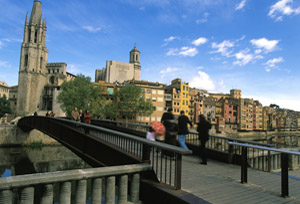
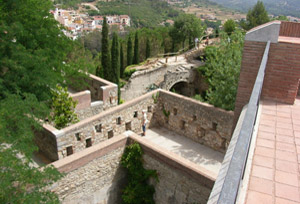
Strategic site on the northern route of the Via Augusta, it was first a Roman city, seat of the bishopric from the 5th century and capital of the earldom of Girona from the Carolingian era. Even in modern times, its resistance in the War against Napoleon (1808-1809) was legendary.
Its old quarter is dominated by the cathedral, with a majestic entrance (a Baroque staircase with almost one hundred steps). It comprises a large Romanesque bell tower and cloister, a Baroque façade and a Gothic nave. Moreover, it is the widest single nave (almost 30 metres) in medieval European architecture. The temple houses an extraordinary Romanesque masterpiece of textile art, the Tapestry of the Creation (11th century). The Chapter Museum exhibits an outstanding Beatus (10th century) by Ende, one of the few named female artists of the Middle Ages. Lovers of Romanesque and Gothic art must pay a visit to the Art Museum housed in the Episcopal Palace.
Behind the cathedral, the stroll along the ancient wall is an unrivalled vantage point. Visitors can gain an insight into Girona’s past at the History Museum. At the foot of the cathedral, visitors can explore the Call or Jewish quarter, few of which have been so well preserved. The streets surrounding Carrer de la Força and the house of Isaac the Blind (now the seat of the Jewish History Museum) were home to an active Jewish community for 600 years until their expulsion in 1492. The Call features its ritual baths, synagogues and an important Kabbalah school with such wise men as Nahmanides, more commonly known in Catalan as Bonastruc ça Porta.
Next to the cathedral, beyond the Sobreportes gateway, are two churches which form the silhouette of the old city: the Monastery of Sant Pere de Galligants (11th-12th century, a former Benedictine abbey), which houses the Archaeological Museum, featuring a magnificent Gothic nave and a cloister, and Sant Feliu, a stone’s throw from the River Onyar, a blend of different styles which in the presbytery conserves the early Christian tombs from the period of Christian persecution. It has a beautiful cloister and a two-floor octagonal bell tower, decorated with double glazing also in Lombard style. Sant Feliu church contains a chapel dedicated to the patron saint of the city. Legend has it that a swarm of flies emerged from the chapel which frightened off the French during the siege of 1285.
The Arab Baths constitute a unique Romanesque building which was designed according to a North-African model.
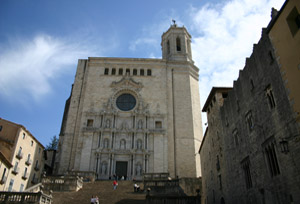
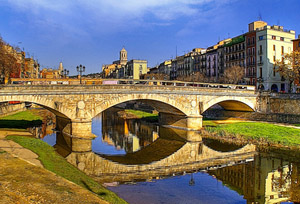
One of the most emblematic images of Girona is that of the buildings on the river Onyar, which crosses the city. This is a series of houses on the river, in height, which are painted in bright colors. The city has eleven bridges over the river, and the best known of all is the Eiffel Bridge, designed by Gustave Eiffel and built shortly before the famous tower in Paris.
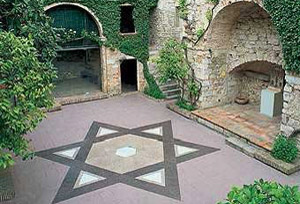
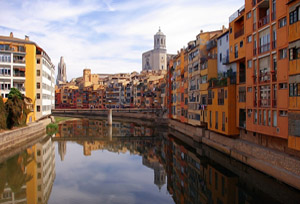
Girona’s historic centre boasts outstanding architecture and unforgettable nooks and crannies: the Church of Sant Nicolau, the Gothic building of Pia Almoina (a medieval charitable institution), the convents of Sant Domènec (now a university building) and El Carme, the mansions flanking Carrer dels Ciutadans such as the Palau Agullana and the Fontana d’Or (which hosts fine exhibitions), the Plaça del Vi, and the archways on Rambla de la Llibertat. However, Girona also has a wealth of popular legends including the witch of the cathedral (a sinner turned to stone, now a gargoyle on the north façade of the cathedral), the Cocollona (the monster that crosses the river on nights with a full moon) and the bottom of the lioness which brings good fortune to those who kiss it (in front of the Church of Sant Feliu). Girona is a city through which to saunter, brimming with myriad restaurants, designer boutiques and handcraft stores.
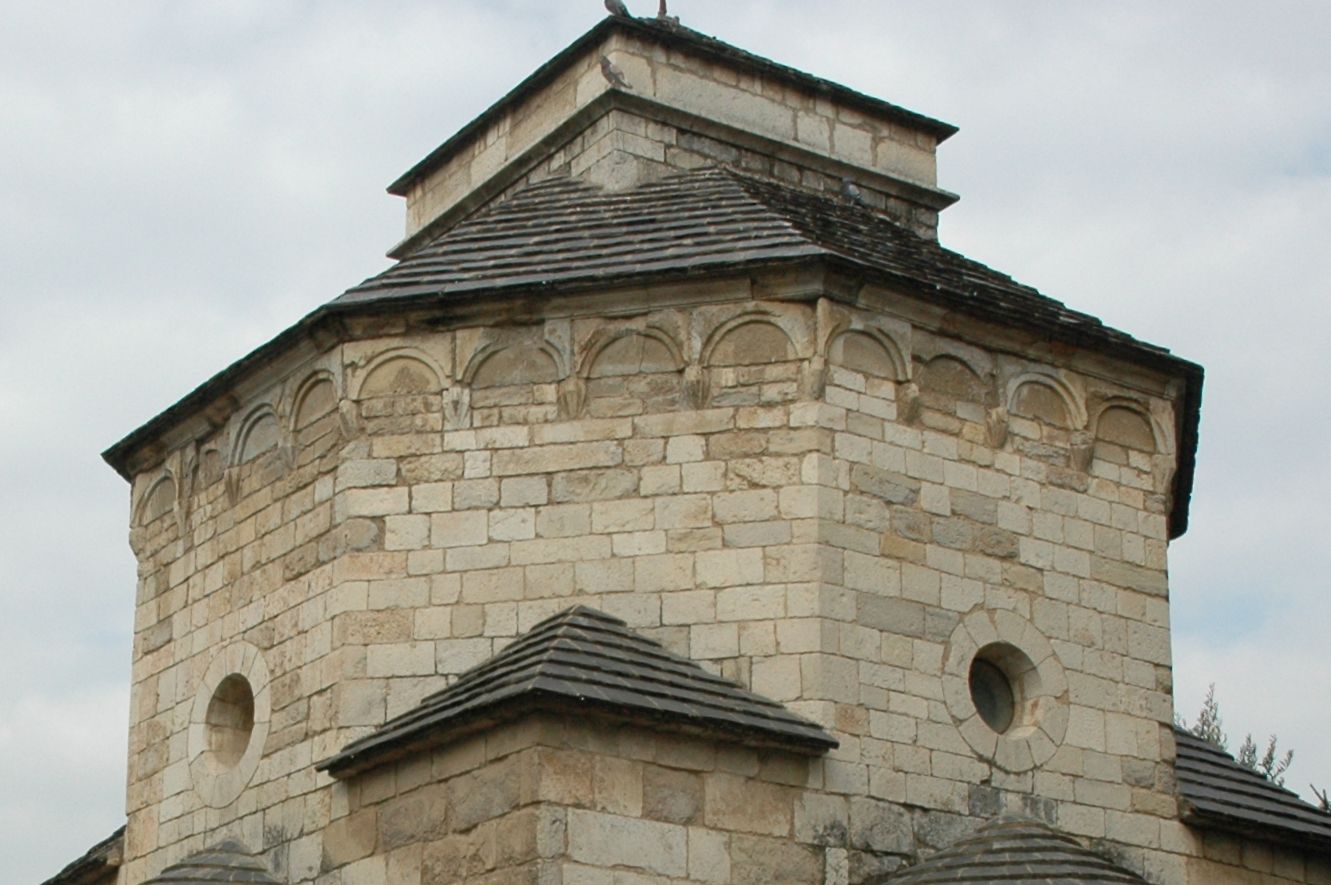
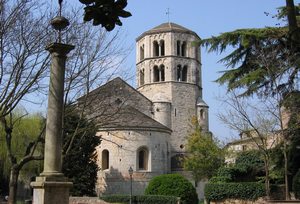
Notable buildings on the other bank of the river include the Farinera Teixidor flour mill and the Casa de la Punxa, part of the legacy of the Noucentista architect Rafael Masó. Visitors to this part of the city can also explore the Cinema Museum, the only one of its kind in Spain. Housing the Tomàs Mallol collection, it is a veritable journey through the passion and ingenuity that made cinema possible.
Map and how to arrive

- Apartments(28)
-
 Villas(1)
Villas(1)
- Hotels(27)
- Feast days(3)
- Churches(6)
- Sights(1)
- Nature reserve(2)
- Museums(5)
- Fortifications(1)
- Castles(1)
- Buildings(5)















